Securing Nfc-based Payment
Cronin; John ; et al.
U.S. patent application number 16/271677 was filed with the patent office on 2019-06-06 for securing nfc-based payment. The applicant listed for this patent is BLAZER AND FLIP FLOPS, INC. DBA THE EXPERIENCE ENGINE. Invention is credited to John Cronin, Seth Melvin Cronin.
| Application Number | 20190172035 16/271677 |
| Document ID | / |
| Family ID | 66098394 |
| Filed Date | 2019-06-06 |
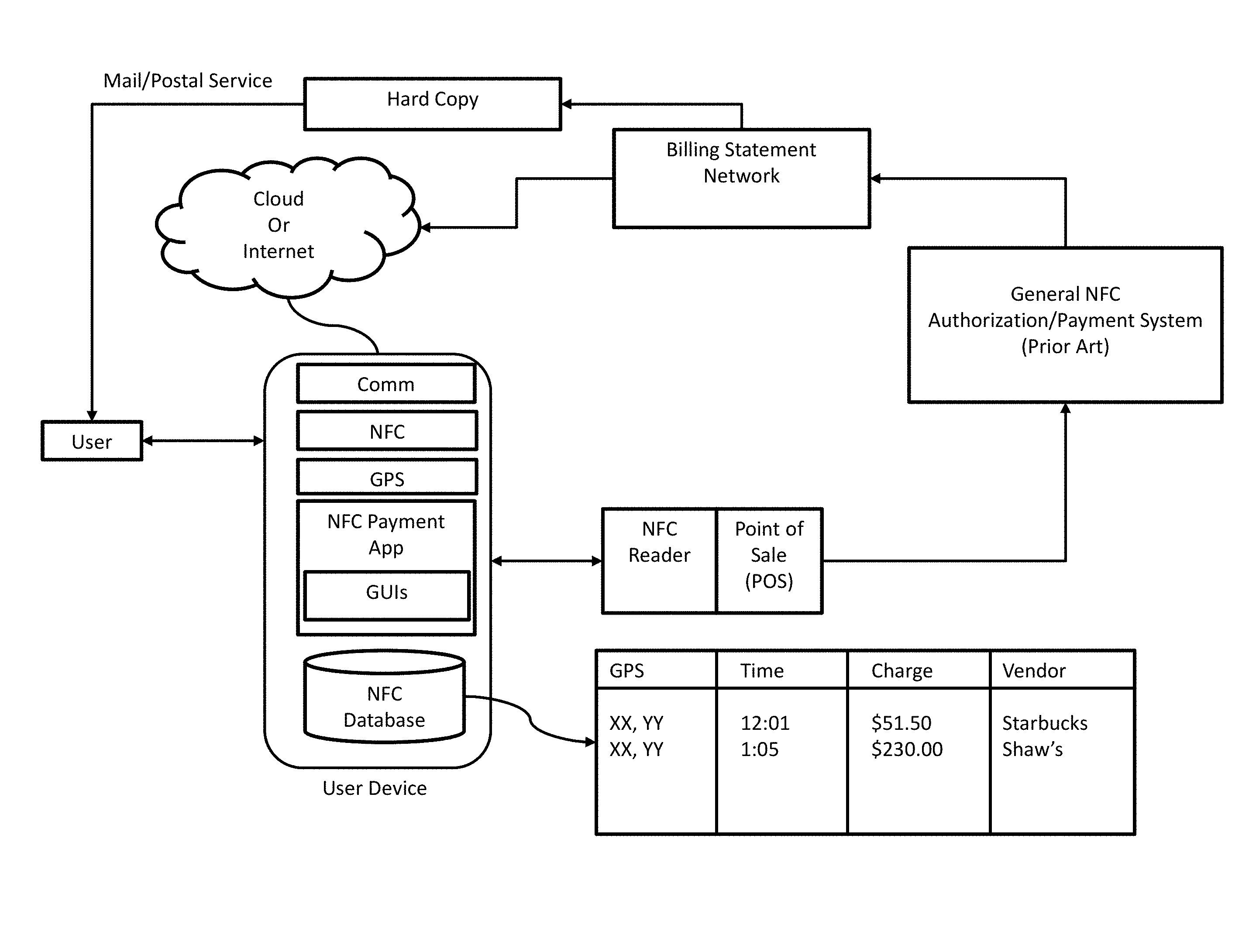
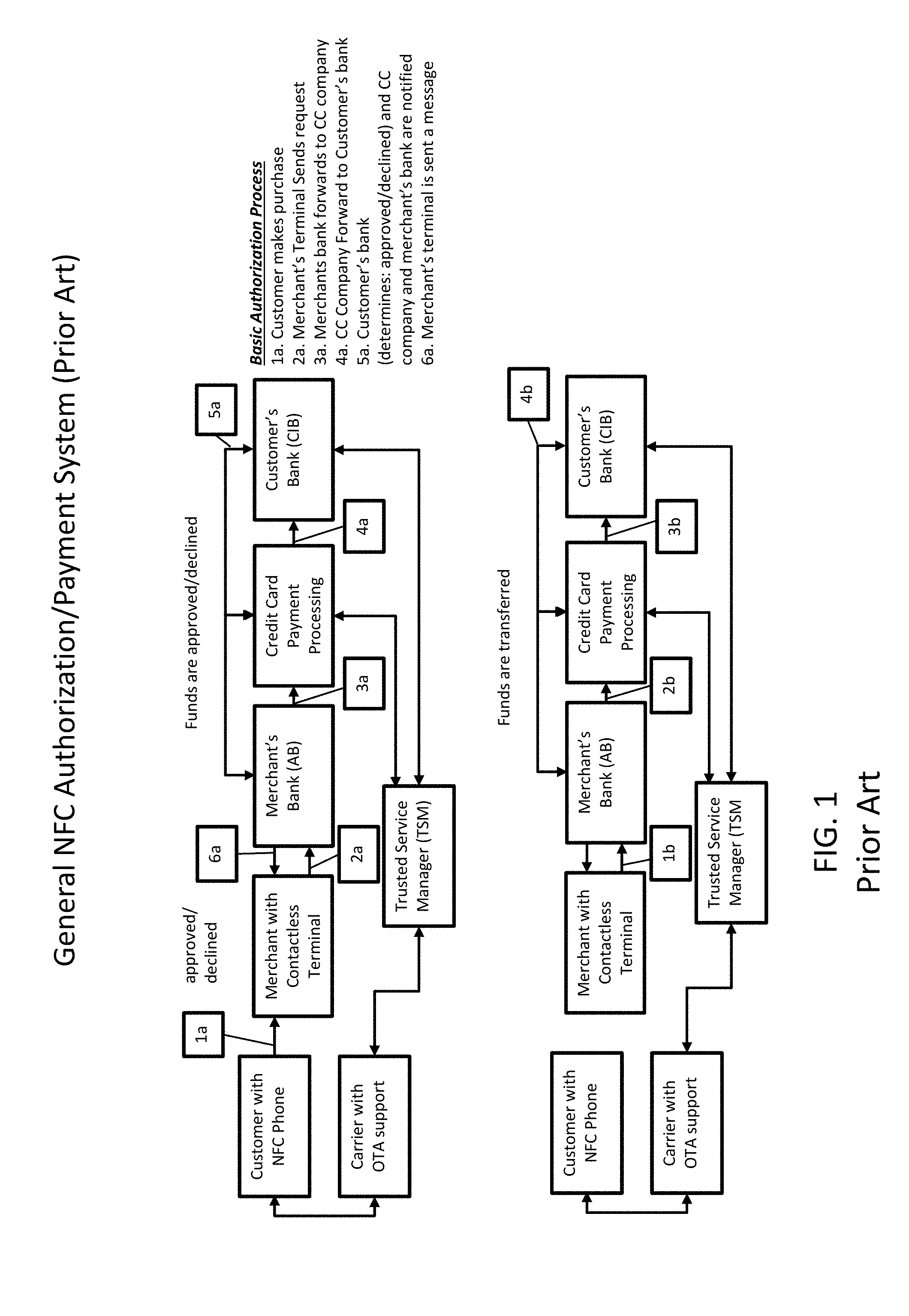


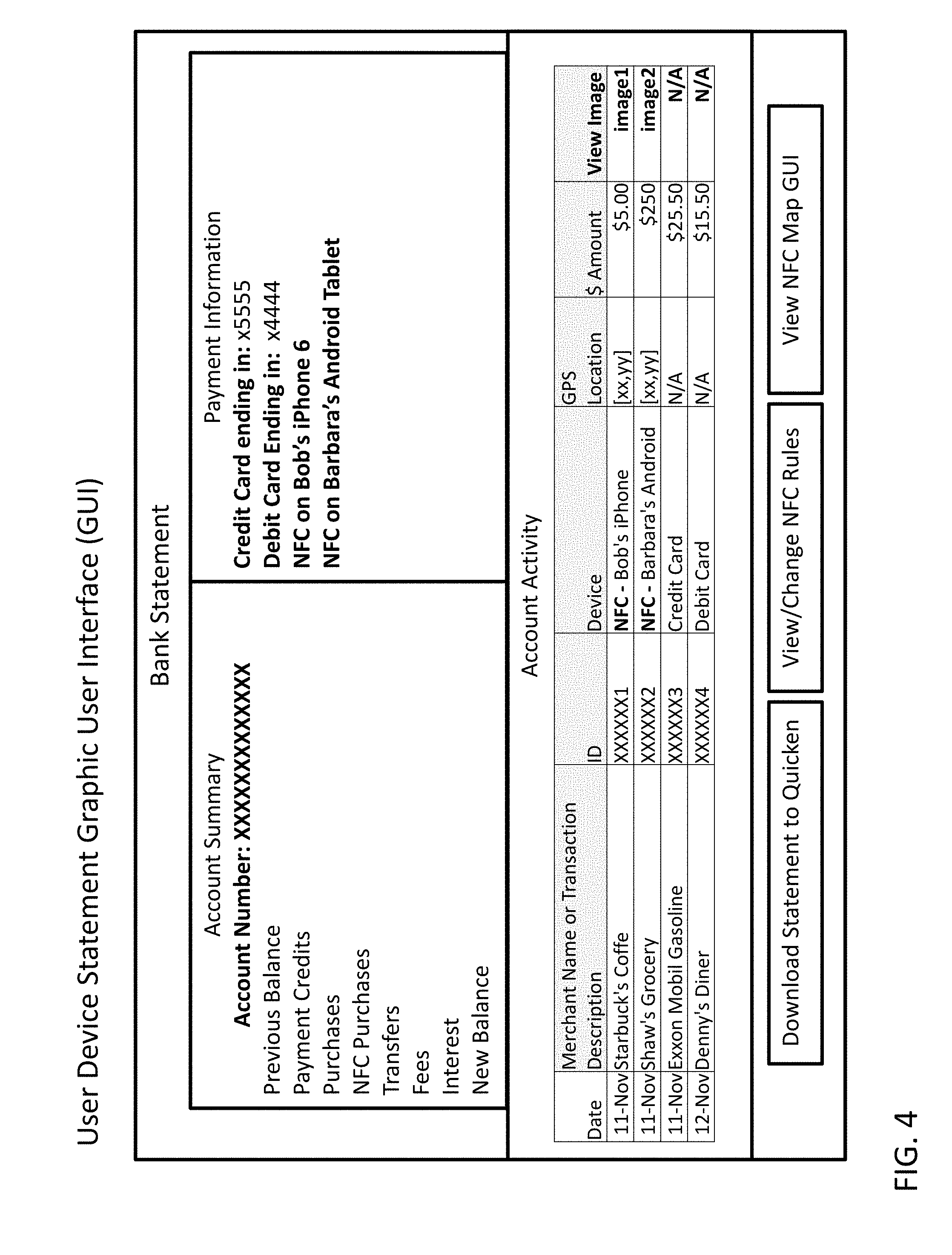
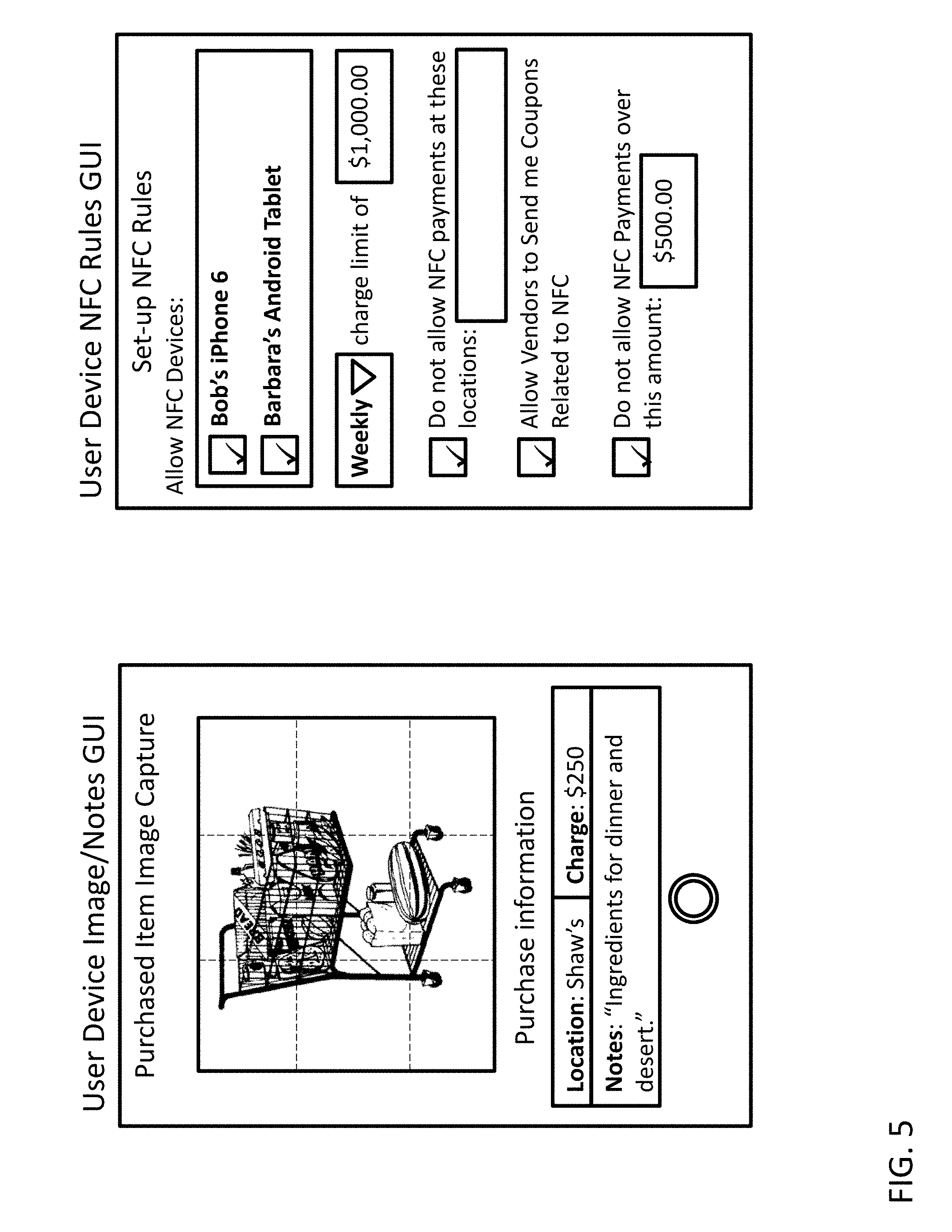

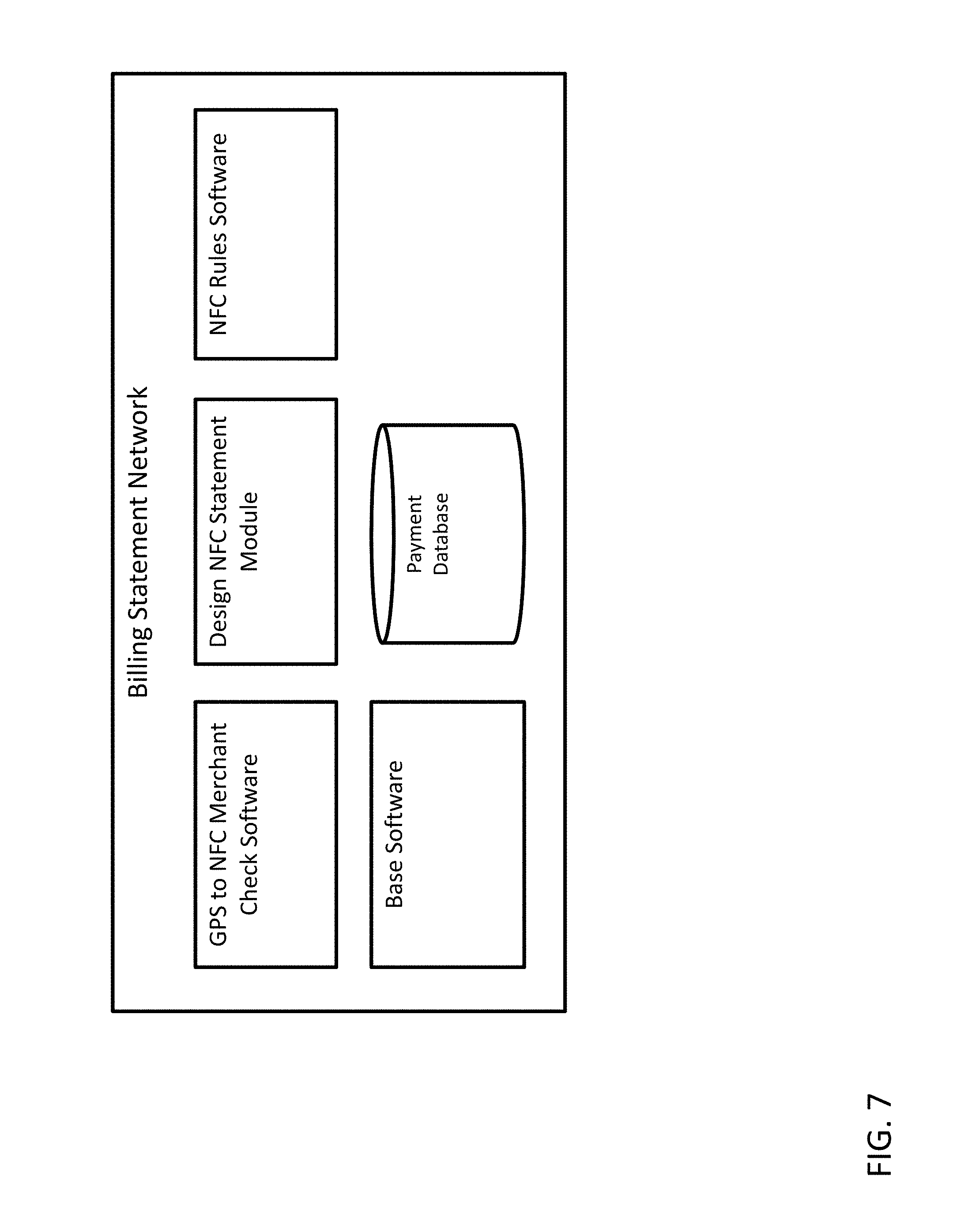
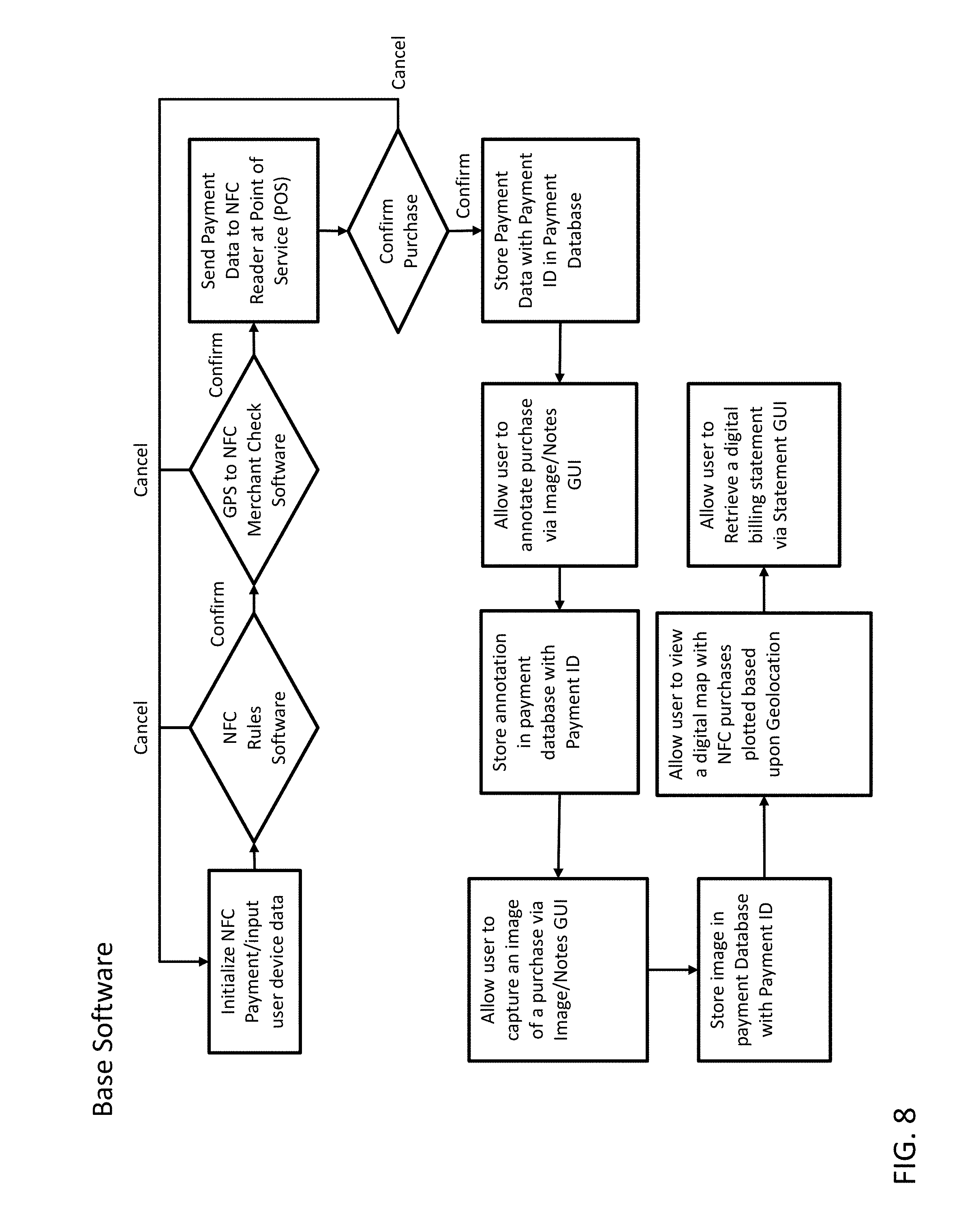



View All Diagrams
| United States Patent Application | 20190172035 |
| Kind Code | A1 |
| Cronin; John ; et al. | June 6, 2019 |
SECURING NFC-BASED PAYMENT
Abstract
The present invention communicates with a point of sale terminal using near field data communications and a purchase is either allowed or denied by a billing statement network according to a set of parameters.
| Inventors: | Cronin; John; (Bonita Springs, FL) ; Cronin; Seth Melvin; (Clarksville, TN) | ||||||||||
| Applicant: |
|
||||||||||
|---|---|---|---|---|---|---|---|---|---|---|---|
| Family ID: | 66098394 | ||||||||||
| Appl. No.: | 16/271677 | ||||||||||
| Filed: | February 8, 2019 |
Related U.S. Patent Documents
| Application Number | Filing Date | Patent Number | ||
|---|---|---|---|---|
| 14970328 | Dec 15, 2015 | 10262311 | ||
| 16271677 | ||||
| Current U.S. Class: | 1/1 |
| Current CPC Class: | G06Q 20/102 20130101; G06Q 20/00 20130101; G06Q 20/202 20130101; G06Q 20/3278 20130101 |
| International Class: | G06Q 20/20 20060101 G06Q020/20; G06Q 20/10 20060101 G06Q020/10; G06Q 20/32 20060101 G06Q020/32 |
Claims
1. A method for securing near field communication (NFC)-based payment, the method comprising: receiving information regarding a requested NFC-based transaction involving a user device, the information received via an NFC interface of the user device; identifying a current location of the user device via a global positioning system (GPS) at a time of the requested NFC-based transaction; and transmitting the received information and the identified current location over a communication network to a network server, wherein the network server further identifies a current location of a merchant associated with the requested NFC-based transaction at a time of the requested NFC-based transaction, and conditions approval of the requested NFC-based transaction on the current location of the user device matching the current location of the merchant.
2. The method of claim 1, further comprising: receiving a request for an NFC-based transactions statement associated with an account of the user device, the request for the NFC-based transactions statement sent to the network server; and generating a display of the requested NFC-based transactions statement on the screen of the user device based on a response sent from the network server, wherein the generated NFC-based transactions statement includes the requested NFC-based transaction among a plurality of NFC-based transactions.
3. The method of claim 2, wherein the NFC-based transactions statement includes a map that illustrates the location of the merchant where the requested NFC-based transaction was made and one or more other locations where other NFC-based transactions were made.
4. The method of claim 2, wherein the received request specifies a time period, and further comprising identifying that the other NFC-based transactions fall into the specified time period.
5. The method of claim 1, further comprising storing one or more rules for NFC-based transactions, and wherein approval of the requested NFC-based transaction is further based on compliance with the stored rules.
6. The method of claim 5, wherein at least one of the rules specifies a location where NFC-based transactions are not allowed, and wherein approval of the requested NFC-based transaction is further based on identifying that the current location is not at the specified location.
7. The method of claim 5, wherein at least one of the rules specifies an amount above which NFC-based transactions are not allowed, and wherein approval of the requested NFC-based transaction is further based on identifying that an amount of the requested NFC-based transaction does not exceed the specified amount.
8. The method of claim 7, wherein the at least one rule further specifies a time period, and wherein approval of the requested NFC-based transaction is further based on identifying that a total amount of NFC-based transactions made within the specified time period does not exceed the specified amount.
9. The method of claim 5, wherein at least one of the rules specifies a set of devices that are allowed to make NFC-based transactions, and d wherein approval of the requested NFC-based transaction is further based on identifying that the user device is part of the specified set.
10. A device for securing NFC-based payment, the device comprising: an NFC interface that receives information regarding a requested NFC-based transaction involving a user device; a global positioning system (GPS) that identifies a current location of the user device at a time of the requested NFC-based transaction; and a wireless communication interface that transmits the received information and the identified current location over a communication network to a network server, wherein the network server further identifies a current location of a merchant associated with the requested NFC-based transaction at a time of the requested NFC-based transaction, and conditions approval of the requested NFC-based transaction on the current location of the user device matching the current location of the merchant.
11. The device of claim 10, further comprising a user interface that: receives a request for an NFC-based transactions statement associated with an account of the user device, the request for the NFC-based transactions statement sent to the network server, and displays the requested NFC-based transactions statement on the screen of the user device based on a response sent from the network server, wherein the generated NFC-based transactions statement includes the requested NFC-based transaction among a plurality of NFC-based transactions.
12. The device of claim 11, wherein the NFC-based transactions statement includes a map that illustrates the location of the merchant where the requested NFC-based transaction was made and one or more other locations where other NFC-based transactions were made.
13. The device of claim 11, wherein the received request specifies a time period, and further comprising identifying that the other NFC-based transactions fall into the specified time period.
14. The device of claim 10, further comprising memory that stores one or more rules for NFC-based transactions, and wherein approval of the requested NFC-based transaction is further based on compliance with the stored rules.
15. The device of claim 14, wherein at least one of the rules specifies a location where NFC-based transactions are not allowed, and wherein approval of the requested NFC-based transaction is further based on identifying that the current location is not at the specified location.
16. The device of claim 14, wherein at least one of the rules specifies an amount above which NFC-based transactions are not allowed, and wherein approval of the requested NFC-based transaction is further based on identifying that an amount of the requested NFC-based transaction does not exceed the specified amount.
17. The device of claim 16, wherein the at least one rule further specifies a time period, and wherein approval of the requested NFC-based transaction is further based on identifying that a total amount of NFC-based transactions made within the specified time period does not exceed the specified amount.
18. The device of claim 14, wherein at least one of the rules specifies a set of devices that are allowed to make NFC-based transactions, and d wherein approval of the requested NFC-based transaction is further based on identifying that the user device is part of the specified set.
19. A non-transitory computer-readable storage medium, having embodied thereon a program executable by a processor to perform a method for securing NFC-based payment, the method comprising: receiving information regarding a requested NFC-based transaction involving a user device, the information received via an NFC interface of the user device; identifying a current location of the user device via a global positioning system (GPS) at a time of the requested NFC-based transaction; and transmitting the received information and the identified current location over a communication network to a network server, wherein the network server further identifies a current location of a merchant associated with the requested NFC-based transaction at a time of the requested NFC-based transaction, and conditions approval of the requested NFC-based transaction on the current location of the user device matching the current location of the merchant.
Description
CROSS-REFERENCE TO RELATED APPLICATIONS
[0001] The present application claims the priority benefit of U.S. patent application Ser. No. 14/970,328 filed Dec. 15, 2015, which claims the priority benefit of U.S. Provisional Application No. 62/093,028 filed Dec. 17, 2014, the disclosures of which are hereby incorporated by reference.
BACKGROUND
Field of the Invention
[0002] The present invention generally relates to near field communications (NFC). More specifically, the present invention relates to a user of a user electronic device equipped with a near field data communication interface that performs financial transactions at point of sale terminals according to set of parameters configured at a billing statement network.
Description of the Related Art
[0003] Near field data communications (NFC) are currently being used by consumers to make secure financial transactions when purchasing goods or services. NFC is a standardized wireless data communication technology that communicates information over short distances. NFC commonly communicates using a frequency of 13.56 megahertz (MHz) with data rates approaching 424 kilo-bits per second (Kbps/sec). NFC equipped devices of various sorts are available in the marketplace today.
[0004] Users of NFC equipped devices currently cannot view a statement that identifies details of purchases made using their user device. Users of NFC data communication interface equipped user device are also currently without a way to setup rules that govern whether an item may be purchased by a particular user device using NFC data communications. Furthermore, there is no systematic way for users of a user device to keep track of NFC purchases with pictures and/or annotations made at the time of the purchase.
[0005] There is a need in the art for a system and method where a user device allows for identification, tracking, annotation, and photographing of information relating to purchases made using a near field data communication interface on a mobile device. Such a system and method would allow the user monitor purchase activity by viewing a statement, and would allow a user to regulate purchase activity of the user device according to a set of rules stored in a remote location.
SUMMARY OF THE PRESENTLY CLAIMED INVENTION
[0006] Embodiments of the present invention include a system and a method for tracking financial transactions using mobile electronic devices equipped with a near field communication (NFC) data communication interface. A method of the present invention may include a user entering information relating to a financial account into a graphical user interface displayed on a display at a mobile electronic device. The information entered may then be transmitted over a data communication interface to a billing statement network that responds by sending billing statement information back to the user device, and the billing statement information may then be received by the user device over the data communication interface. The billing statement information from the billing statement network may be displayed in a graphical user interface (GUI) on a display at the user device. In certain instances the billing statement information is displayed according to a set of settings or parameters set by the user of the user device at an earlier time. The billing statement information may also identify purchases that were purchased over a NFC data communication interface.
BRIEF DESCRIPTION OF THE DRAWINGS
[0007] FIG. 1 illustrates a prior art basic authorization process and a basic prior art payment process.
[0008] FIG. 2 illustrates a user device communicating with a billing statement network over the cloud or internet.
[0009] FIG. 3 illustrates a user device.
[0010] FIG. 4 illustrates a bank statement graphical user interface (GUI) that may be displayed on a display at a user device.
[0011] FIG. 5 illustrates an image captured by a user device that may be displayed in an image/notes GUI.
[0012] FIG. 6 illustrates a map that identifies locations where a user made a purchase using NFC data communications in a user device NFC map GUI.
[0013] FIG. 7 illustrates a billing statement network.
[0014] FIG. 8 illustrates an exemplary flow chart of functionality that may be included in a base software of a billing statement network.
[0015] FIG. 9 illustrates an exemplary flow chart of NFC rules software.
[0016] FIG. 10 illustrates an exemplary flow chart of GPS to NFC merchant check software.
[0017] FIG. 11 illustrates an exemplary method corresponding to the present invention.
DETAILED DESCRIPTION
[0018] Embodiments of the present invention include a system and a method for processing payments at private enterprises using mobile electronic devices equipped with near field data communication (NFC) functionality.
[0019] Mobile electronic devices described herein include, but are not limited to smartphones, iPhones, Android phones, iPads, notebook computers, computers built into a car, and mobile devices dedicated to performing NFC communications. Mobile devices may include a processor, and a memory. Mobile devices may also or alternatively include a field programmable gate array (FPGA), or a an application specific integrated circuit (ASIC).
[0020] The various methods may be performed by software operating in conjunction with hardware. For example, instructions executed by a processor, the instructions otherwise stored in a non-transitory computer readable medium such as memory. Various interfaces may be implemented--both communications and interface. One skilled in the art will appreciate the various requisite components of a mobile device and integration of the same with one or more of the figures and/or descriptions included herein.
[0021] A private payment network as described herein includes, but is not limited to a computer and a computer server.
[0022] FIG. 1 illustrates a prior art basic authorization process and a basic prior art payment process. FIG. 1 illustrates two separate flow charts, a first flow chart of a prior art basic authorization process, and a second flow chart of a basic prior art payment process. The basic authorization process begins with a customer with a phone that supports NFC communications sending a purchase order 1a to a merchant with a contactless terminal. The merchant with the contactless terminal then sends a request 2a to the merchant bank. Next the merchant bank forwards credit card information 3a provided with the purchase order to a credit card payment processing center. The credit card payment processing center then forwards the credit card information 4a to the customer bank, and the customer bank approves or declines the purchase 5a. Next a message is sent back to the merchant 6a indicating that the purchase has been approved or declined.
[0023] FIG. 1 also indicates that funds are approved or declined using a combination of the merchant bank, the credit card payment processing center, and the customer bank. FIG. 1 also depicts alternate communication pathways for performing the transactions. The alternative communication pathway includes a trusted service manager (TSM) communicating with the customer bank and with the credit card payment processing center. The TSM is an entity that serves a trusted intermediary between mobile devices, networks that service mobile devices, and software applications. The TSM securely coordinates payments from a financial institution to a merchant that have been authorized by a mobile device. The alternate pathway also includes a carrier with over the air (OTA) support communicating with the TSM and with the customer phone. Examples of a carrier with OTA support are cellular companies like Verizon, AT&T, and T-Mobile. The basic authorization process may be performed using older phone lines or it may be performed using modern wireless cellular networks.
[0024] The basic payment process of FIG. 1 illustrates the merchant sending a settlement request 1b to the merchant bank, the merchant bank then sends a settlement request 2b to the customer bank. Next the customer bank transfers funds to the merchant bank 4b. FIG. 1 shows that communications between the merchant bank, the credit card payment processing center, and the customer bank are used to transfer from the customer bank to the merchant bank. The basic payment flow chart also shows a customer phone communicating with a carrier with OTA support, and with a TSM. Here the TSM also communicates with the credit card payment system and with the customer bank.
[0025] FIG. 2 illustrates a user device communicating with a billing statement network over the cloud or internet. The user device is depicted as communicating with a general NFC payment authorization system over a point of sale terminal. FIG. 2 also depicts the general NFC payment authorization system communicating with the billing statement network. The general NFC payment authorization system of FIG. 2 may be the same prior art general NFC payment authorization system depicted in FIG. 1. FIG. 2 also depicts a user interacting with the user device and the user receiving a hard copy of a statement from the billing statement network that was mailed to the user.
[0026] The user device includes a communication interface, a NFC data communication interface, a global positioning system (GPS), a NFC payment application (App) that includes a graphical user interface (GUI), and an NFC database. The NFC payment application may communicate with the NFC payment authorization system over the NFC data communication information and over a NFC data communication interface at the point of sale terminal.
[0027] The communication interface communicating over the cloud or internet may be any communication interface, including but not limited to Bluetooth, Wi-Fi (802.11), or a cellular 3G-4G LTE network. Other communications networks, protocols, and standards may be used. The NFC database is depicted as including historical information relating to financial transactions that the user has previously performed. For example, the database includes a transaction for the amount of $51.50 occurred at Starbucks at 12:01 pm at a GPS location (XX, YY).
[0028] In operation, the user device may communicate using NFC data communications with the point of sale terminal that in turn may communicate with the general payment authorization system that may communicate with the billing statement network when processing a transaction. The billing statement network may then communicate with the user device over the cloud or internet a communication relating to the transaction. The billing statement network may also arrange for a hard copy statement to be mailed to the user after the transaction is complete.
[0029] FIG. 3 illustrates a user device. The user device is depicted as including a memory, a communications module, an NFC data communication interface, a GPS system, a processor, an input/output (I/O) interface, and a camera connected with a communication bus. The memory in the user device is depicted as including an NFC payment App, and an NFC database. The NFC payment App includes a statement GUI, a NFC map GUI, an image/notes GUI, and a NFC rules GUI. The various GUIs depicted in FIG. 3 may be used by a user to order or review a statement, review a map, make notes or images, or review NFC rules.
[0030] FIG. 4 illustrates a bank statement graphical user interface (GUI) that may be displayed on a display at a user device. The bank statement includes an account summary information, payment information, account activity information, and several selection boxes. The selection boxes depicted include download statement to quicken, view/change NFC rules, and view an NFC map GUI.
[0031] The account summary includes an account balance, credits, purchase information, NFC purchase history information, transfer information, interest earned, and a new balance. The payment information includes a partial credit card number, a partial debit card number, and previous payment history (i.e., NFC on Bob iPhone 6). The account activity includes a plurality of fields that include: a transaction date, a merchant name, a transaction identifier (ID), a device name, a GPS location, a transaction amount, and an optional image. The statement tracks transactions performed at various merchants and cross references a device name that was used to perform the transaction with other information. Image information may be a photo taken at the time that the transaction occurred. An example transaction occurred on November 12 at Dennys diner using a debit card for an amount of $15.50. Since this transaction was processed using a debit card, no GPS location data or image data is available. In contrast, a second example transaction that occurred on November 11 at Shaw grocery was processed using a NFC communication interface on Barbara Android phone. This second example transaction occurred at GPS location (xx, yy) and includes image data.
[0032] Statement information may be downloaded to quicken accounting software when the download statement to quicken selection box is selected. A user may view or change rules that enable, disable, or configure NFC communications at the user device. A user may also view the NFC map GUI by selecting the view NFC map GUI selection box.
[0033] FIG. 5 illustrates an image captured by a user device that may be displayed in an image/notes GUI. FIG. 5 also depicts an example of a user device NFC rules GUI. The image displayed in the user device image/notes GUI is a grocery cart full of groceries. Purchase information in the image/notes GUI indicates that the groceries were purchased at Shaw groceries, a charge of $250.00, and a note of "ingredients for dinner and desert." The button depicted in the image/notes GUI may be used to acquire an image and store that image in a database.
[0034] The user device NFC rules GUI indicates that allowed NFC devices are Bob iPhone 6, and Barbara Android tablet. FIG. 5 depicts a charge limit of $1000.00 per month rule. This rule may limit NFC charges of a user configured amount spanning a time selected by the user in the GUI. The rules GUI also depicts selection boxes "do not allow NFC payments at these locations," "allow vendors to send me coupons related to NFC," and "do not allow NFC payments over this amount $500.00." FIG. 5 also includes an entry box that may be used to identify location where NFC payments should not be allowed. Thus, a user of the user device may define rules regarding how and where NFC data communications may be used by one or more user devices.
[0035] FIG. 6 illustrates a map that identifies locations where a user made a purchase using NFC data communications in a user device NFC map GUI. FIG. 6 depicts numerous recent purchase locations (A-F). FIG. 6 depicts a vendor name, and a time when each purchase was made. Each entry in the map is also cross referenced to notes that may have been entered, to a picture (pic) that may have been taken at the purchase location, and to a charge charged at the location. For example, location D identifies that a payment was made at a diner at 9:50 am. By selecting a notes, a pic, or a charge selection box under the location identifier D, a user may view a note, view a picture, or review a charge made at location D. The map also includes selection boxes sort by and back to billing statement. Selection box "sort by" identifies that only recent purchase are displayed in the map. Selection box "back to billing statement," when selected will allow a user to go back and view a billing statement, which may be like the billing statement depicted in FIG. 4.
[0036] FIG. 7 illustrates a billing statement network. The billing statement network in FIG. 7 includes a GPS to NFC merchant check software, base software, design NFC statement module, a NFC rules software, and a payment database.
[0037] The GPS to merchant check software may check the GPS location of a user device and a merchant to see if they are in the same location when authorizing a purchase. The base software in FIG. 6 provides the billing statement network with basic billing functions.
[0038] The design statement module is a software module that may allow a user to customize how their billing statements appear. For example, a user may configure their statement to include an icon of an image acquired during purchases in the statement when an image is available. The NFC rules software is a software module that may enforce rules setup by a user of the user device. The rules GUI as discussed in respect to FIG. 5 provides examples of rules that may be enforced by the NFC rules software.
[0039] Finally, the payment database in FIG. 7 is a database that includes purchase information, such as the purchase information discussed in respect to FIGS. 2, 5, and 6.
[0040] FIG. 8 illustrates an exemplary flow chart of functionality that may be included in a base software of a billing statement network. A first step in the flow chart is a step that may enable NFC payments inputs to be input (initialized) in the base software. The second step in FIG. 8 is a first determination step, this step determines whether a transaction input into the base software conforms to rules in set in the rules software. When the transaction does conform to the rules, the flow chart moves to a third step in the flow chart, otherwise the transaction is cancelled.
[0041] The third step in FIG. 8 is a second determination step, where a geo-location of the merchant is checked against a geo-location of the user device. When the geo-locations match, the flow chart proceeds to a fourth step in the flow chart, otherwise the transaction is cancelled (as the transaction appears to be a fraudulent transaction). In step four of the flow chart payment data a user device sends payment information over a point of sale terminal to a point of sale service (POS). A geo-location may be a street address or correspond to a latitude and a longitude.
[0042] Next in a fifth step of the flowchart a third determination is determined. The third determination step may determine that the purchase should be processed. When it is confirmed that the purchase should be processed, program flow flows to a sixth step in FIG. 8, otherwise the transaction is cancelled. In the sixth step of the flowchart payment data and a payment identifier (ID) are stored in a payment database. Then in a seventh step, a user may be allowed to annotate the purchase and enter an image using the image/notes GUI in FIG. 5. In an eight step of FIG. 8 the annotation is stored in the payment database.
[0043] Next in step nine of the flow chart as illustrated in FIG. 8, the user is allowed to capture an image that may be stored in the database and cross referenced to the purchase, to the purchase ID, and to any notes or images captured relating to the purchase. After the image is captured it may be stored in the payment database in step ten of the flow chart.
[0044] In an eleventh step of the flow chart, the user may be allowed to view NFC purchases made on a digital map displayed in a GUI at the user device. The map may include the geo-location where the purchase was made. Finally, in a twelfth step of the flow chart, a user may retrieve a billing statement and view that statement in a statement GUI.
[0045] FIG. 9 illustrates an exemplary flow chart of NFC rules software. A first step in the flow chart may receive payment data from base software at the billing statement network of FIG. 7. A second step in the flow chart is a determination step where the NFC device may be approved to execute a transaction. When the NFC device may perform a transaction, program flow flows to a third step in the flow chart, otherwise the transaction moves to a step where the purchase is cancelled. The third step in the flow chart determines whether the purchase history associated with the mobile device is below a weekly charge limit, when yes, program flow moves to a fourth step in the flow chart, otherwise program flow moves to the step where the purchase is cancelled.
[0046] The fourth step of the flow chart determines whether the location where the purchase is being performed is an approved location, when yes, program flow moves to a fifth step of the flow chart. When the location is an approved location, program flow moves to a fifth step of the flow chart, otherwise program flow moves to the step where the purchase is cancelled. The fifth step in the flow chart determines whether the amount or cost of the purchase is an allowed amount. When the amount is an allowed amount, program flow flows to a sixth step in the flow chart where the purchase is confirmed. When the amount is not allowed program flow moves from the fifth step to the step where the purchased is cancelled.
[0047] FIG. 10 illustrates an exemplary flow chart of GPS to NFC merchant check software. FIG. 10 begins with a first step where payment data is received from the payment database at the billing statement database. In a second step of the flow chart the geo-location of the user device is received, and then the geo-location of the merchant is retrieved in a third step of the flow chart. Next the merchant check software may determine whether the geo-location of the user device matches the geo-location of the merchant. When the geo-location match, the purchase is confirmed in a fifth step of the flow chart. When the geo-locations do not match, the purchase is cancelled in a sixth step of the flow chart.
[0048] FIG. 11 illustrates an exemplary method corresponding to the present invention. The method begins with a first providing step where a billing statement network may be provided with GPS merchant check software, design NFC statement module software, NFC rules software, base software, and a payment database.
[0049] The second step of the flow chart is also a providing step where a user device may be provided with a NFC communication interface, another communication interface, a GPS system, an NFC payment App and GUIs, and an NFC database. In the second step of the flow chart, a user device may communicate over the cloud or internet with the billing statement network of FIG. 2.
[0050] The third step of the flow chart may allow a user to setup NFC rules in the billing statement network over a GUI displayed on a display at the user device. Then in a fourth step of the flow chart the NFC rules may be stored in a payment database at the billing statement network. Next in a fifth step of the flow chart, the user may be allowed to initiate an NFC payment transaction.
[0051] The sixth step of the flow chart is where base software at the billing statement network may be executed. Then in a seventh step, the user may be allowed to input annotations or images relating to the purchase over an image/notes GUI at the user device. The eighth step of the flow chart is where the images and/or the annotations input in step seven may be stored in the payment database of the billing statement network.
[0052] In step nine of FIG. 11, a user of the user device may design a billing statement by interacting with the billing module software at the billing statement network. Here again this interaction may be performed over a GUI at the user device.
[0053] Finally, in step ten of the flow chart a user may be allowed to view a billing statement sent from the billing statement network. The statement may be viewed over a billing GUI or a map GUI on the user device.
[0054] While various embodiments have been described above, it should be understood that they have been presented by way of example only, and not limitation. The descriptions are not intended to limit the scope of the invention to the particular forms set forth herein. Thus, the breadth and scope of a preferred embodiment should not be limited by any of the above-described exemplary embodiments. It should be understood that the above description is illustrative and not restrictive. To the contrary, the present descriptions are intended to cover such alternatives, modifications, and equivalents as may be included within the spirit and scope of the invention as defined by the appended claims and otherwise appreciated by one of ordinary skill in the art. The scope of the invention should, therefore, be determined not with reference to the above description, but instead should be determined with reference to the appended claims along with their full scope of equivalents.
* * * * *
D00000

D00001

D00002

D00003

D00004

D00005

D00006

D00007

D00008

D00009

D00010

D00011

XML
uspto.report is an independent third-party trademark research tool that is not affiliated, endorsed, or sponsored by the United States Patent and Trademark Office (USPTO) or any other governmental organization. The information provided by uspto.report is based on publicly available data at the time of writing and is intended for informational purposes only.
While we strive to provide accurate and up-to-date information, we do not guarantee the accuracy, completeness, reliability, or suitability of the information displayed on this site. The use of this site is at your own risk. Any reliance you place on such information is therefore strictly at your own risk.
All official trademark data, including owner information, should be verified by visiting the official USPTO website at www.uspto.gov. This site is not intended to replace professional legal advice and should not be used as a substitute for consulting with a legal professional who is knowledgeable about trademark law.